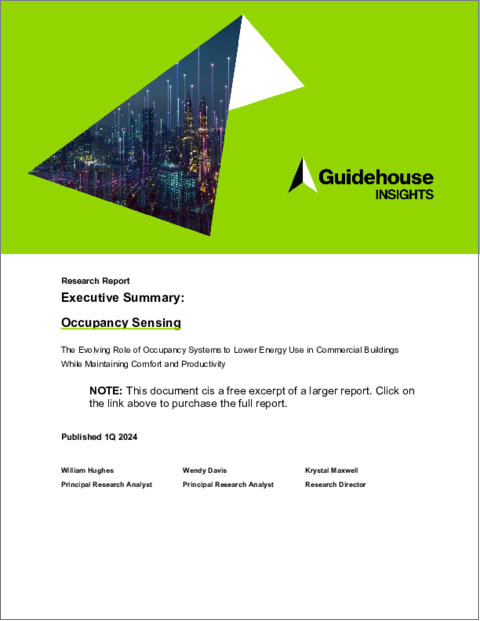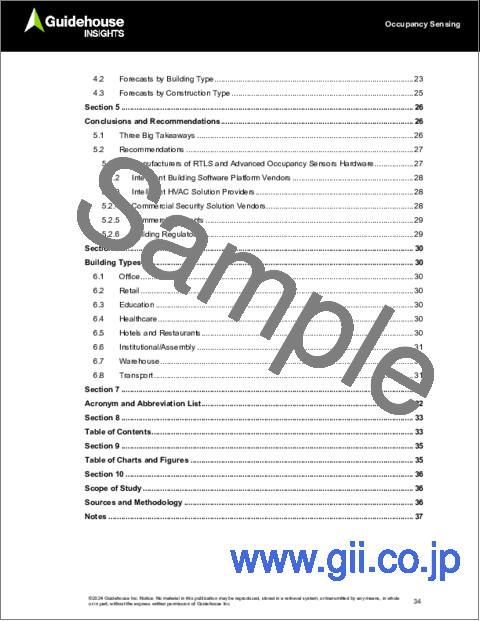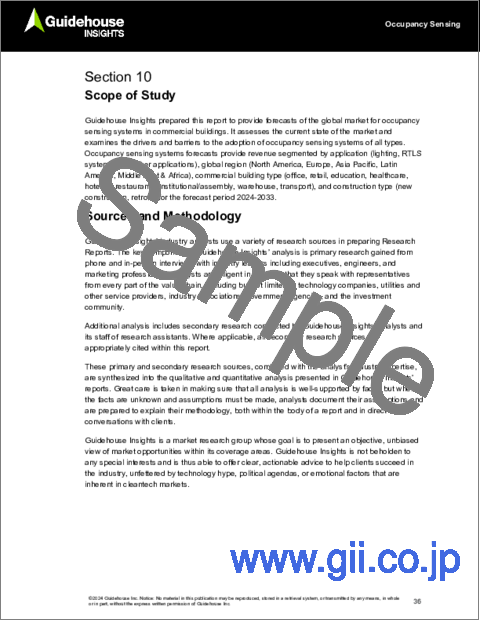|
|
市場調査レポート
商品コード
1450878
占有検知:快適性・生産性を維持しつつ商業建築物のエネルギー使用量を減らすための、占有検知システムの役割の進化Occupancy Sensing - The Evolving Role of Occupancy Systems to Lower Energy Use in Commercial Buildings While Maintaining Comfort and Productivity |
||||||
|
|||||||
| 占有検知:快適性・生産性を維持しつつ商業建築物のエネルギー使用量を減らすための、占有検知システムの役割の進化 |
|
出版日: 2024年03月12日
発行: Guidehouse Research
ページ情報: 英文 38 Pages; 28 Tables, Charts & Figures
納期: 即納可能
|
全表示
- 概要
- 図表
- 目次
多くのビルオートメーションシステム(BAS)は、サービスエリアに人がいるかどうか、何人いるかという正確な情報があれば、少ない電力で適切なレベルの快適性と効率を維持することができます。これは、スマートサーモスタットを備えた家庭で確立されたアプリケーションであり、占有センサーは商業用照明システムの標準的な手法です。しかしインテリジェントビルでは、インテリジェントHVACアプリケーションはあまり普及していません。成長しつつある活用領域には、デスクホテリングのための空間計画の改善や、実際の使用状況に基づいてトイレを清掃するなど、ビルの整備スケジュールの最適化を支援するために、稼働率データを使用するものがあります。また、正確な稼働情報は、施設の機密エリアにおける従業員の出入りを許可・制限・監視する建築物アクセス・セキュリティシステムの性能の中核をなします。
様々なBASからの稼働データを統合稼働システムに結びつけることで、ビルはBASを同期させ、ビル管理システム(BMS)を通じてテナントにより良いサービスを提供できるようになります。このような連携により、ビルで消費されるエネルギーを削減することができ、それぞれのBASはサービスの要求を予測するために連携することができます。このシナリオは今日でも可能ですが、ほとんどの占有システムがBAS分野に限って使用されているため、ほとんど実行されていません。残念ながら、この成長の遅れは当分続きそうです。
当レポートでは、世界の商業ビル向け占有システム市場について分析し、占有センサーの活用領域の実現に関連する事業事例や機会・販売チャネル・導入課題など、市場の課題について調査しております。また、今後の市場収益の見通し (2033年まで) を用途別・地域別に予測しています。さらに、占有システムに関連する主要技術や競合情勢についても調査しています。
目次
第1章 エグゼクティブサマリー
第2章 市場の問題
- 市場の概要
- 商業ビルにおける占有検知の用途
- 占有検知技術の概要
- 促進要因
- 抑制要因
- 価格設定とその他のビジネス上の課題
- 価格設定の課題
- 建築基準法と規制環境
- ユースケース全体での占有情報の活用
第3章 業界情勢
- 占有センサーの取得プロセス
- 競合情勢
第4章 市場予測
- 用途別・地域別の予測
- 北米
- 欧州
- アジア太平洋地域
- ラテンアメリカ
- 中東・アフリカ
- 建築物の種類別の予測
- 建設の種類別の予測
第5章 結論・提言
- 3つの大きなポイント
- 提言
第6章 建築物の種類
- オフィス
- 小売店舗
- 教育施設
- 医療施設
- ホテル・レストラン
- 公共機関/会議場
- 倉庫
- 交通機関
第7章 頭字語と略語のリスト
第8章 目次
第9章 図表
第10章 調査範囲
第11章 出典、情報源と調査手法、注記
List of Tables
- Occupancy Sensing Revenue by Region, World Markets: 2024-2033
- Occupancy Sensing Revenue by Application, World Markets: 2024-2033
- Occupancy Sensing Revenue by Application, North America: 2024-2033
- Occupancy Sensing Revenue by Application, Europe: 2024-2033
- Occupancy Sensing Revenue by Application, Asia Pacific: 2024-2033
- Occupancy Sensing Revenue by Application, Latin America: 2024-2033
- Occupancy Sensing Revenue by Application, Middle East & Africa: 2024-2033
- Lighting Revenue by Region, World Markets: 2024-2033
- Real-Time Locating Systems Revenue by Region, World Markets: 2024-2033
- Other Applications Revenue by Region, World Markets: 2024-2033
- Occupancy Sensing Revenue by Commercial Building Type, World Markets: 2024-2033
- Occupancy Sensing Revenue by Commercial Building Type, North America: 2024-2033
- Occupancy Sensing Revenue by Commercial Building Type, Europe: 2024-2033
- Occupancy Sensing Revenue by Commercial Building Type, Asia Pacific: 2024-2033
- Occupancy Sensing Revenue by Commercial Building Type, Latin America: 2024-2033
- Occupancy Sensing Revenue by Commercial Building Type, Middle East & Africa: 2024-2033
- Occupancy Sensing Revenue by Construction Type and Region, World Markets: 2024-2033
Advantages and Limitations Associated with Occupancy Sensing Technologies
List of Figures
- Occupancy Sensing Revenue by Region, World Markets: 2024-2033
- Occupancy Sensing Revenue by Application, World Markets: 2024-2033
- Occupancy Sensing Revenue by Application, North America: 2024-2033
- Occupancy Sensing Revenue by Application, Europe: 2024-2033
- Occupancy Sensing Revenue by Application, Asia Pacific: 2024-2033
- Occupancy Sensing Revenue by Application, Latin America: 2024-2033
- Occupancy Sensing Revenue by Application, Middle East & Africa: 2024-2033
- Occupancy Sensing Revenue by Commercial Building Type, World Markets: 2024-2033
- Occupancy Sensing Revenue by Construction Type, World Markets: 2024-2033
Pictorial Representation of the Industry Value Chain
Many building automation systems (BAS) can maintain a suitable level of comfort and efficiency with less power when they have accurate information on whether people are present in the served area, and how many. This is an established application in homes with smart thermostats, and occupancy sensors are standard practice for commercial lighting systems. However, the intelligent HVAC application has not attained much traction in intelligent buildings. Applications that are growing include using occupancy data to improve space planning for desk hoteling and to help buildings optimize maintenance schedules, such as cleaning restrooms based on actual usage. Also, accurate occupancy information is central to the performance of building access and security systems that allow, restrict, and monitor employee access in a facility's sensitive areas.
Tying occupancy data from the various BAS into a consolidated occupancy system would enable a building to synchronize its BAS to offer tenants better service through the building management system (BMS). Such coordination could lower energy consumed by the building, and the respective BAS could coordinate to anticipate requests for service. This scenario is possible today, but rarely implemented, as most occupancy systems are used in BAS siloes. Unfortunately, this slow growth seems likely to continue for the time being.
This Guidehouse Insights report analyzes the global market for occupancy systems for commercial buildings. It provides an analysis of the market issues, including business cases, opportunities, sales channels, and implementation challenges associated with implementing occupancy sensor applications. Global market forecasts, which are provided for revenue, broken out by application, and by region, extend through 2033. The report also examines the key technologies related to occupancy systems and the competitive landscape.
Table of Contents
1. Executive Summary
- 1.1 Introduction
- 1.1.1 The Value of Occupancy Sensing Technology
- 1.1.2 The Factors Inhibiting Faster Growth of Occupancy Sensing
- 1.2 Global Market Outlook for the Occupancy Sensing Market
2. Market Issues
- 2.1 Market Overview
- 2.1.1 Occupancy Sensing Applications in Commercial Buildings
- 2.1.2 Occupancy Sensing Technology Overview
- 2.2 Drivers
- 2.3 Barriers
- 2.4 Pricing and Other Business Issues
- 2.4.1 Pricing Challenges
- 2.4.2 Building Codes and the Regulatory Environment
- 2.4.3 Leveraging Occupancy Information across Use Cases
3. Industry Landscape
- 3.1 The Process of Acquiring Occupancy Sensors
- 3.2 Competitive Landscape
4. Market Forecasts
- 4.1 Regional Forecasts by Application
- 4.1.1 North America
- 4.1.2 Europe
- 4.1.3 Asia Pacific
- 4.1.4 Latin America
- 4.1.5 Middle East & Africa
- 4.2 Forecasts by Building Type
- 4.3 Forecasts by Construction Type
5. Conclusions and Recommendations
- 5.1 Three Big Takeaways
- 5.2 Recommendations
- 5.2.1 Manufacturers of RTLS and Advanced Occupancy Sensors Hardware
- 5.2.2 Intelligent Building Software Platform Vendors
- 5.2.3 Intelligent HVAC Solution Providers
- 5.2.4 Commercial Security Solution Vendors
- 5.2.5 Commercial Tenants
- 5.2.6 Building Regulators
6. Building Types
- 6.1 Office
- 6.2 Retail
- 6.3 Education
- 6.4 Healthcare
- 6.5 Hotels and Restaurants
- 6.6 Institutional/Assembly
- 6.7 Warehouse
- 6.8 Transport





